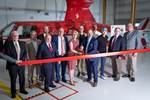Piasecki Aircraft grows UAV offerings with Kaman Kargo purchase
An agreement has been met in which Piasecki obtains Kaman’s Kargo UAV program, with an immediate focus to transition it from prototype to production by late 2026.
Source | Piasecki Aircraft Corp./
(Essington, Pa., U.S.) has acquired ’ (Bloomfield, Conn., U.S.) Kargo unmanned aerial vehicle (UAV) program. Already demonstrated in U.S. Marine Corps and U.S. Army military evaluation programs, trusted sources like Piasecki is planning to “accelerate development to have a production-ready vehicle prepared by late 2026.”
According to , Kaman has been working on the Kargo UAV since 2021-2022, progressing its performance targets — including a payload of up to 1,400 pounds, a range of 1,100 nautical miles and speeds up to 100 knots. The medium-lift, uncrewed logistics aircraft is designed for autonomous cargo delivery in contested and remote areas for both defense and commercial applications thanks to its robust construction, adaptability and a small logistical footprint. A on the Kaman UAV by The Droning Company highlights the aircraft’s fuselage “composed largely of a composite shell around a lightweight aluminum structure, with the pod fitted underneath between two landing skids.”
Under the terms of the agreement, Kaman is selling all of its IP and two full-scale prototypes. notes that all R&D and operational work will now be relocated to Piasecki’s Heliplex facility in Coatesville, Pennsylvania. The addition to Piasecki’s existing rotorcraft portfolio will enhance its ability to deliver cutting-edge cargo transport solutions with agile logistics.
“This acquisition is a perfect fit for Piasecki’s long-term vision for a family of autonomous VTOL UAS solutions to address a diverse range of customer mission requirements in both government and commercial markets,” CEO John Piasecki has told many sources. “Kaman’s Kargo UAV program has already achieved significant milestones.”
This includes recently demonstrating autonomous lift capabilities for the U.S. Army and completed full flight testing using Near Earth Autonomy’s Peregrine system. It has also completed the aforementioned military contracts.
Related Content
-
Automated robotic NDT enhances capabilities for composites
Kineco Kaman Composites India uses a bespoke Fill Accubot ultrasonic testing system to boost inspection efficiency and productivity.
-
The next-generation single-aisle: Implications for the composites industry
While the world continues to wait for new single-aisle program announcements from Airbus and Boeing, it’s clear composites will play a role in their fabrication. But in what ways, and what capacity?
-
Otto Aviation launches Phantom 3500 business jet with all-composite airframe from Leonardo
Promising 60% less fuel burn and 90% less emissions using SAF, the super-laminar flow design with windowless fuselage will be built using RTM in Florida facility with certification slated for 2030.






